Ministries Tags: presbyterians today
Presbyterians Today’s
The Presbyterian Resource Guide for Ministry
A Comprehensive Reference Handbook for congregations
At last, here’s an easy-to-read, in-depth guidebook that puts loads of vital ministry information at your fingertips. The Resource Guide covers dozens of subjects, including disaster response, fundraising and stewardship, the ins and outs of building a website and using social media, children’s/youth/collegiate/young adult ministry, church planting, grant and scholarship sources, evangelism, worship… and much more. Packed with practical and useful tips, stories, articles, and contacts, this comprehensive, one-stop reference is an essential asset for congregations, presbyteries, and individual Presbyterians …
Continue readingBible Explorations
The Rule of the Last
Have we been interpreting Scripture wrongly all this time?
by Aric Clark
Even when I am sitting alone in a cozy nook with a blanket and a cup of tea, reading is an inherently social act. Not only am I interacting with the thoughts of the author, but also a complex social web informs my reading. That book found its way into my possession through social interactions. Whether literature or nonfiction, it almost certainly belongs to a genre informed by a series of social conventions. Most importantly, my interpretation of the content will be heavily shaped by my experiences and social location. I am a straight, cisgendered, educated, white male. I bring all of that with me to the text.
If this is true of all reading, it is even truer of Scripture, which is frequently read in the communal settings of worship and study, thick with socially constructed rules of interpretation. We never read the Bible alone, and the people we read the Bible with are the most significant influence over how we understand and apply it in our lives.
Continue reading The art of rehabilitation
The art of rehabilitation
Prison programs tap inmates’ creativity to spark transformation behind walls.
By Hans Hallundbaek
When Dorothy in The Wizard of Oz said, “There’s no place like home,” she surely wasn’t thinking of the place that’s “home” to Shaquan Dunkin. In fact, to Dunkin and roughly 1,600 other men, this “home” is more often called The Big House. It’s Sing Sing Correctional Facility, a fortresslike maximum-security prison 30 miles north of Manhattan. Surrounded by watchtower-topped concrete walls and miles of razor wire, Sing Sing is where many men will spend 10, 15, 20, or more years of their lives—even if they get out of prison eventually.
It’s the last place you’d expect to find Munchkins, wizards, and flying monkeys.
Continue readingPreview of the October 2014 Issue
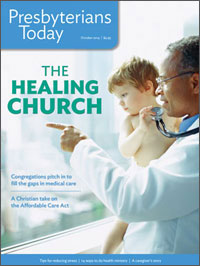 The church as health clinic
The church as health clinic
Congregations pitch in to help fill the gaps in medical care.
by Cary Estes
She was the type of person who often slips through the cracks of society: no insurance, more than $10,000 in medical bills, and blood pressure that had soared into stroke range. She could not afford to be treated, but without treatment she could not continue working as a housekeeper—which meant that she wouldn’t be able to earn the money to pay for treatment.
The woman desperately needed a helping hand in order to find a healing hand. And she managed to receive that assistance from Lois Bazhaw, a nurse who belongs to Faith Presbyterian Church in Greensboro, North Carolina. The woman had come to Faith Presbyterian for the church’s food pantry, and while there explained her situation to Bazhaw.
Continue readingPreview of the JANUARY/FEBRUARY 2015 Issue
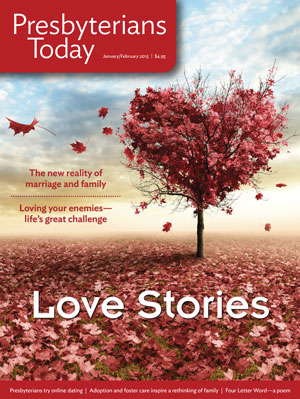 The new reality of marriage
The new reality of marriage
Changes in society lead to questions about what it means to be married.
by Marci Glass
When Esther Olsen graduated from high school in the mid-1950s, she did what many other young women of that era did: enrolled in nursing school. Soon afterward, she started dating George Auld, a respiratory therapist. When the couple got married, nursing school fell by the wayside. By society’s standards, Esther didn’t need a career anymore—she’d found a husband. And, predictably, children followed a few years later.
By all accounts, George and Esther were living the American dream.
I should know; I’ve heard the story many times. George and Esther are my parents.
By the time I went to college in the late ’80s, I could no more imagine dropping out of college to get married than I could picture going to Mars. I did get married a year out of college, even if that was not my plan.
The first time we talked, I told my future husband, “I’m so glad I’m single and won’t be following some guy around the country after graduation.”
Continue reading‘The perpetual rule of love’
Creating effective, lasting social change is difficult; fortunately, you’re not alone.
by Rick Jones and Ginna Bairby
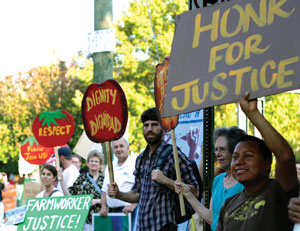
A year and a half ago, Colleen Earp sat in a room full of Young Adult Volunteers weary from an intense week of orientation and eager to start their year of service. Presbyterian World Mission would soon be placing each of them with a nonprofit or ministry somewhere in the United States or around the world. As Earp listened to her colleagues’ musings about a year of sharing the gospel and addressing injustice, she couldn’t help but laugh; she was thinking about planting trees.
Over the next year, Earp worked with First Presbyterian Church of Bayou Blue, Louisiana, as a wetlands conservationist and advocate in the New Orleans area. Before becoming a YAV, she had never laid eyes on a bayou. A year later, Earp had come to know the wetlands of Louisiana—and the church working to protect them—as her second home.
Continue readingPreview of the MARCH/APRIL 2016 Issue
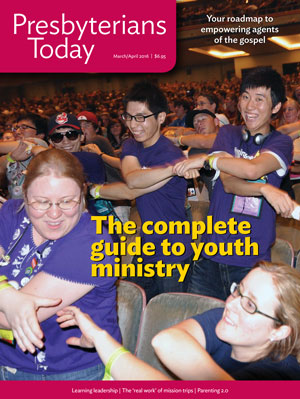 The secret to youth ministry
The secret to youth ministry
Empowering agents of the gospel
by Chanon Ross
It was a hot August night, and Atlanta’s Buckhead Theatre had been reserved for a special gala to honor 15 remarkable teenagers. With the help of GivingPoint, a leading youth philanthropy organization, these youth had launched nonprofit organizations that were addressing significant social problems such as homelessness, teen pregnancy, poverty, and inadequate education. I was eager to talk with them, but so were more than 100 guests in attendance that night. Many of them swarmed the youth like groupies at a rock show, and I quickly realized that getting face time with even one of the young people wasn’t going to be easy.
I tried to edge my way into a conversation with one of the youth and found myself rubbing shoulders with two women who were so focused on him that they were unaware of me. I leaned in and jockeyed for an even better position, really wanting to hear what the young man had to say.
Continue readingPreview of the MARCH 2015 Issue:
Presbyterian Resource Guide for Ministry
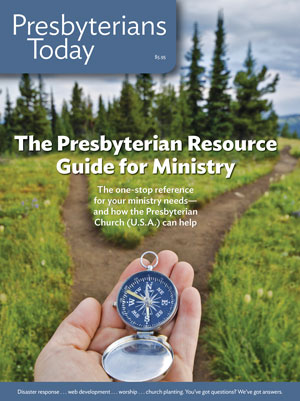 Top 14 ways the Presbyterian Mission Agency can help
Top 14 ways the Presbyterian Mission Agency can help
Why we’re part of a connected church with international resources and relationships
1 Faith in action. We’re here to help you find the particular calling God has placed on your life. Maybe you’ll devote a year to service by becoming a Young Adult Volunteer, travel to the United Nations to help set global standards for gender equality, begin a ministry with veterans, or start a community garden.
2 Worship. Whether you’re looking for a daily devotional app, the new Presbyterian hymnal, or creative worship ideas, you’re sure to find what you need.
Continue reading Go Figure
Go Figure
Triennium changes lives
by Joelle Kopacz
Common sense would tell us that Presbyterian Youth Triennium is a good thing. How could it be anything but good to gather thousands of Presbyterian youth and leaders from across the country to worship and grow in their faith? Yet you might still be surprised to see just how good Triennium is!
Those who attended the most recent Triennium (2013) have overwhelmingly been positively affected by the event, which has often prompted them to grow in their faith and to share this faith with others. Presbyterian youth report developing leadership skills to exercise in their peer groups and congregations.
Yet youth aren’t the only ones benefitting from Triennium. Among congregational leaders who attended the 2013 Triennium, many have been equipped with new energy and knowledge to help their congregations grow. Some have even developed new ministries as a result of Triennium. These leaders feel especially equipped to help their congregations strengthen their youth ministry, worship, and overall vision.
When asked what about the experience was so formative, 51 percent named relationships and a feeling of connectedness at Triennium. Another 31 percent identified worship as the most important factor.
The next Triennium is coming up in just a few short months. If you are a leader in your congregation, consider joining your church’s youth at this event. Worship with them, grow with them, and dream with them about the future of your congregation—and of the denomination.
Continue reading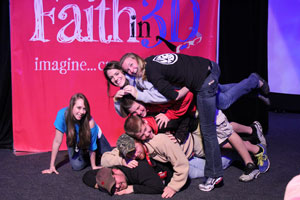 Unleashed
Unleashed
The top 10 things to look for in an effective, faithful youth ministry
By Gina Yeager-Buckley
I am stuck. I am “on” for teaching Sunday school this Sunday. It’s the day after two more episodes of violence—the shootings in San Bernardino, California, and Savannah, Georgia. It’s also Advent, and our two students, Annie and Abby, both delightful and compassionate young women, will not likely relish talking about more violence.
I feel ill at the idea of exposing them to any more of this mess. And there’s only the two of them. Yes, two. I am one of several youth-ministry volunteers at a small and wonderful church. Our youth class has two students and three teachers. We rotate so as not to overwhelm Abby and Annie with our sometimes-too-exuberant affection for them.
That love makes this moment all the more difficult. I feel lost and anxious about how to do an Advent lesson without being upfront about so much evil in the world.
Looks like I am not alone in my worry about Sunday’s lesson, either. When I log onto my work email (I am the Presbyterian Mission Agency’s associate for youth ministries), I find 10 messages from people across the nation asking me about curriculum for talking with youth about violence.
Continue reading